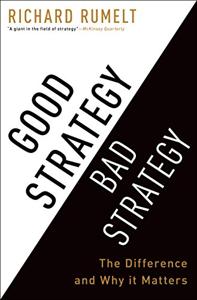
Want to learn the ideas in Good Strategy Bad Strategy better than ever? Read the world’s #1 book summary of Good Strategy Bad Strategy by Richard Rumelt here.
Read a brief 1-Page Summary or watch video summaries curated by our expert team. Note: this book guide is not affiliated with or endorsed by the publisher or author, and we always encourage you to purchase and read the full book.
Video Summaries of Good Strategy Bad Strategy
We’ve scoured the Internet for the very best videos on Good Strategy Bad Strategy, from high-quality videos summaries to interviews or commentary by Richard Rumelt.
1-Page Summary of Good Strategy Bad Strategy
Overview
What separates winning strategies from losing ones? Both set out to achieve the same goals, but they end up with different results. It turns out that part of this difference lies in what we consider a strategy; some people don’t even have actual strategies!
In this passage, the author offers insights on strategic thinking. He draws from successful and unsuccessful cases to illustrate how people can become more effective strategists. By examining those examples, you’ll learn about the anatomy of a successful strategy and how to apply it in your life or business.
You’ll also learn why you should be wary of sexy-sounding fluff, how one man’s epiphany in Italy lead to a chain of 4,500 coffee shops, how to look beneath the obvious to find hidden powers and maximize their impact. You’ll grasp what all good strategies have in common – and what bad ones lack.
Big Idea #1: Don’t confuse strategy with ambitious goal setting, visions or slogans.
What is a Strategy?
A major graphic arts company had a strategy of achieving 20 percent revenue and profit increases. Do you think this was a good strategy? The short answer is no, because the goals are not connected with actionable ideas that will get them to their goal. A vision or goal is just an idea by itself; it needs to be tied in with other ideas that will help achieve those goals.
A vision or a goal can be an effective way to start a strategy, but the strategy itself must include information on how goals will actually be achieved.
For example, if your football coach tells you to win the next game, he isn’t telling you anything useful unless he gives you a plan of action. For instance, when he says “win the next game,” is that all? Or does he give specific instructions on how to win?
People often mistake their goals for strategies. They also pass off motivational slogans as strategies, too.
When someone tries to impress you with a lot of fluff, it’s usually because they don’t have anything else to say. They’re just trying to make themselves look smart by using big words that mean nothing and are only there for show.
A major retail bank’s strategy is a perfect example of how to make a message clear. It was “customer-centric intermediation,” which means that they take deposits and lend them out to others while focusing on the customer. By taking out unnecessary words and phrases, we can easily see that their strategy was simply “to be a bank.”
Both of these business examples lack a plan for action. If you don’t have a plan, then you don’t really have strategy.
Big Idea #2: Every good strategy has the same foundation: a diagnosis, a guiding policy and a set of coherent actions.
Every strategy is different because it’s tailored to a specific need. However, there is one thing that every successful strategy has in common: the kernel. It consists of three parts: the diagnosis, which breaks down complex circumstances into a simple analysis, and the guiding policy, which lays out an approach for addressing those circumstances.
IBM was in a decline during 1993. The company had previously been successful with its strategy of offering complete computers, but that didn’t work anymore because other companies started selling individual parts.
Many believed that IBM would have to adapt to the changing market, but CEO Lou Gerstner thought differently. He decided instead of fragmenting and separating departments, they should centralize them and become leaders in IT consulting.
The company realized that they needed to focus on the customer. They created a new guiding policy and then made sure it was effective by ensuring that their actions wouldn’t contradict one another.





